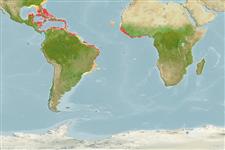Environment / Climate / Range
Ecology
Marine; reef-associated; depth range 0 - 100 m (Ref. 5979), usually 0 - 20 m (Ref. 40849). Tropical, preferred ?; 34°N - 25°S, 91°W - 5°E
Western Atlantic: Florida (USA), Bermuda, and the Bahamas to Brazil. Absent in Gulf of Mexico (Ref. 26938). Eastern Atlantic: Ascension Island and the Gulf of Guinea (Ref. 5979).
Size / Weight / Age
Maturity: Lm ? range ? - ? cm
Max length : 46.0 cm TL male/unsexed; (Ref. 5979); common length : 35.0 cm TL male/unsexed; (Ref. 3275)
Dorsal
soft rays
(total): 92-99;
Anal
soft rays: 71 - 76. Gray to brown with numerous circles, curved spots, and dots of light blue on head and body; fins with small light blue spots; two or three large diffuse blackish spots on straight portion of lateral line (Ref. 13442).
Inhabits clear sandy areas near mangroves, among seagrass, coral or rubble (Ref.9710). Most common flounder around coral reefs (Ref. 26938). Often partially buried in sand, occasionally on hard bottoms (Ref. 9710). Feeds mainly on small fishes but also on crustaceans and octopuses. Marketed fresh (Ref. 5217).
Life cycle and mating behavior
Maturity | Reproduction | Spawning | Eggs | Fecundity | Larvae
Robins, C.R. and G.C. Ray, 1986. A field guide to Atlantic coast fishes of North America. Houghton Mifflin Company, Boston, U.S.A. 354 p. (Ref. 7251)
IUCN Red List Status (Ref. 115185)
CITES (Ref. 94142)
Not Evaluated
Threat to humans
Harmless
Human uses
Fisheries: minor commercial; aquarium: commercial
More information
Common namesSynonymsMetabolismPredatorsEcotoxicologyReproductionMaturitySpawningFecundityEggsEgg development
ReferencesAquacultureAquaculture profileStrainsGeneticsAllele frequenciesHeritabilityDiseasesProcessingMass conversion
Tools
Special reports
Download XML
Internet sources
